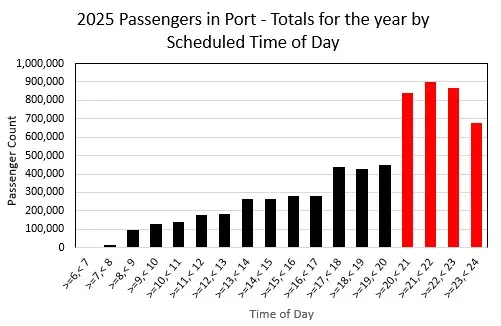
The analysis below is based on the GVHA schedule as of 12th February 2025. The first cruise ship is scheduled to arrive on 6th March.
Summary
Key points from the report below are:
- 320 ships and 980,000 passengers are scheduled for 2025 (p1)
- Mostly late departures (p5) with 73% departing after 11pm and 63% at midnight (p7). 88% depart after 10pm.
- 54% of ships arrive at or after 7pm (p10) with passengers spending an average of just 4 hours in port – and approximately 2 hours on shore, if they choose to disembark. This, in addition to onboard accommodation and dining, likely accounts for the low level of cruise passenger spending on shore (less than 2% of the region’s tourism expenditure).
- In June there are 2 days without cruise ships, July 4 days and August 3 days (p6).
- 47% of cruise ships are in port for less than 4 hours and 54% for less than 5 hours (p6).
- Short stops in Victoria allow ships to (1) avoid the PVSA penalty of $US996 per passenger (over $US4 million for the largest ships) and (2) dump their garbage in Victoria.
- The hourly greenhouse gas (GHG) emission rate when 3 ships are in port is approximately 47% of the City of Victoria’s average hourly rate (p17).
- The average passenger time in port is 6.0 hours (p1) down from 6.7 hours in 2019. The average ship time in port is 6.3 hours (p8). The difference between “Passenger time” and “Ship time” is due to the larger ships having shorter stays.
Report
Despite both the residents’ and the City of Victoria’s concerns there appears to be no limit to the annual growth of cruise ship numbers.
At a time when the environment should be our highest priority the cruise industry continues to deliver increasing amounts of green house gas, noise, speeding traffic and international garbage to our community.
